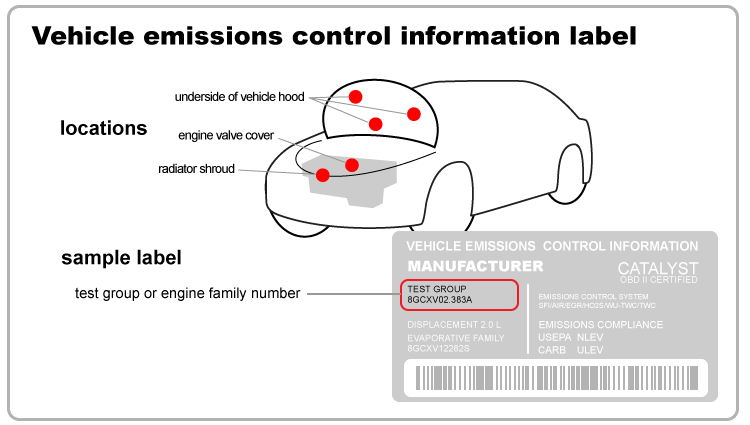
Frequently Asked Questions
We can help
Haven't found what you are looking for? Contact Helpline for assistance.
- Abrasive Blasting Program
- Aftermarket, Performance, and Add-on Parts
- On-Road Motorcycles
- Senate Bill 1137: Establishment of Health Protection Zones, Oil and Gas Production Wells and Production Facilities
- Small Off-Road Engines (SORE)
- Spark-Ignition Marine Watercraft
- Truck and Bus Regulation
- Zero-Emission Vehicle Program
Recreational Vehicles & Watercraft
No, the SIMW regulation requires that all testing must be performed by an independent laboratory according to §2856(a)(3)(D). Independent laboratory is defined per §2853(a)(18). Note that the durability portion of test procedures can be performed in-house, but the test data must be generated by an independent laboratory.
Zero-Emission Transportation
All vehicles that comply with California regulations have a Vehicle Emissions Information label on a visible location on the vehicle. In addition to listing all equipment used on the vehicle to comply with California requirements, the label lists the vehicles test group or Engine family Number. This number can be cross referenced on our website by checking the Executive Order for the year make and Test Group.
New vehicles that have not yet been registered will also have a Manufacturers Certificate of Origin that will state the standards that the vehicle complies with and list the manufacturers legal name so that you can cross reference that information with the Executive Order.
Vehicles without these required information labels are not legal for sale in California.

Lawn, Garden & Landscape Equipment
Any alternative test procedure shall only be used if prior written approval is obtained from the CARB. In order to secure the CARB's approval of alternative test procedures, the applicant is responsible for demonstrating to the CARB's satisfaction that the alternative test procedures are equivalent to the required test procedures. Alternative test procedures may be submitted to the following address:
California Air Resources Board
Monitoring Laboratory Division
P.O. Box 2815
Sacramento, CA 95812
Attn. Division Chief
California Code of Regulations, title 13, section 2766(a) provides an exemption from the requirements of section 2755 for metal tanks, coextruded multilayer tanks, and structurally integrated nylon tanks on SORE equipment with engine displacement less than 80 cc. Section 2755 contains the permeation emissions performance standard for equipment that use engines with displacement less than or equal to 80 cc.
This exemption does not apply to any fuel tank for use on SORE equipment with engine displacement greater than 80 cc. Permeation emissions data or the Executive Order number of a certified fuel tank must be provided in certification applications for equipment using engines with displacement greater than 80 cc meeting the design standards of Cal. Code 11/9/2015 Page 15 of 16 Regs., title 13, section 2754(b) beginnin
Yes. When it comes to using two carbon canisters on a separate two tank system, CARB approves the use of one canister for each separate tank as long as the canister’s working capacity is compatible to the size of the tank.
However, when it comes to using multiple canisters in sequence for one large fuel tank, CARB would require that the canister manufacturer apply for a new component EO under the innovative products program. Canisters in sequence must be tested per TP-902 and the working capacity data should be submitted with the request for a new component EO. As with single carbon canister EOs, the working capacity of the canisters in sequence should determine the maximum fuel tank capacity.
Yes it is acceptable for the component label to be obscured by another piece of the equipment as long as the equipment certification label is visible and states that the equipment is certified to California standards.
Manufacturers using a component whose EO has been revoked will be required to stop installing that component on engines or equipment once the 11/9/2015 Page 14 of 16 EO is revoked. If they are unable to substitute another certified component or otherwise meet the requirements set forth in sections 2754 through 2757 of the regulation, they can apply for a variance pursuant to section 2768.
This is acceptable; however, the manufacturer applying for certification will ultimately be responsible. In other words, if Company A is the certification holder, but Company B's name is on the warranty statement, CARB will hold Company A responsible.
For component certification under Section 2767.1, CARB requires that emissions data from each of the five samples comply with the specified performance requirement. CARB will ensure that each data point is below the specified requirement and that the specified test method was used.
Section 2767.1 requires the manufacturer to submit emissions data from a minimum of 5 component samples. Multiple samples of a component that show compliance with specified performance requirements provide CARB with a greater assurance that the component will perform as intended.
Glossary
Have you ever wondered what a baghouse is or what NMOG stands for?
